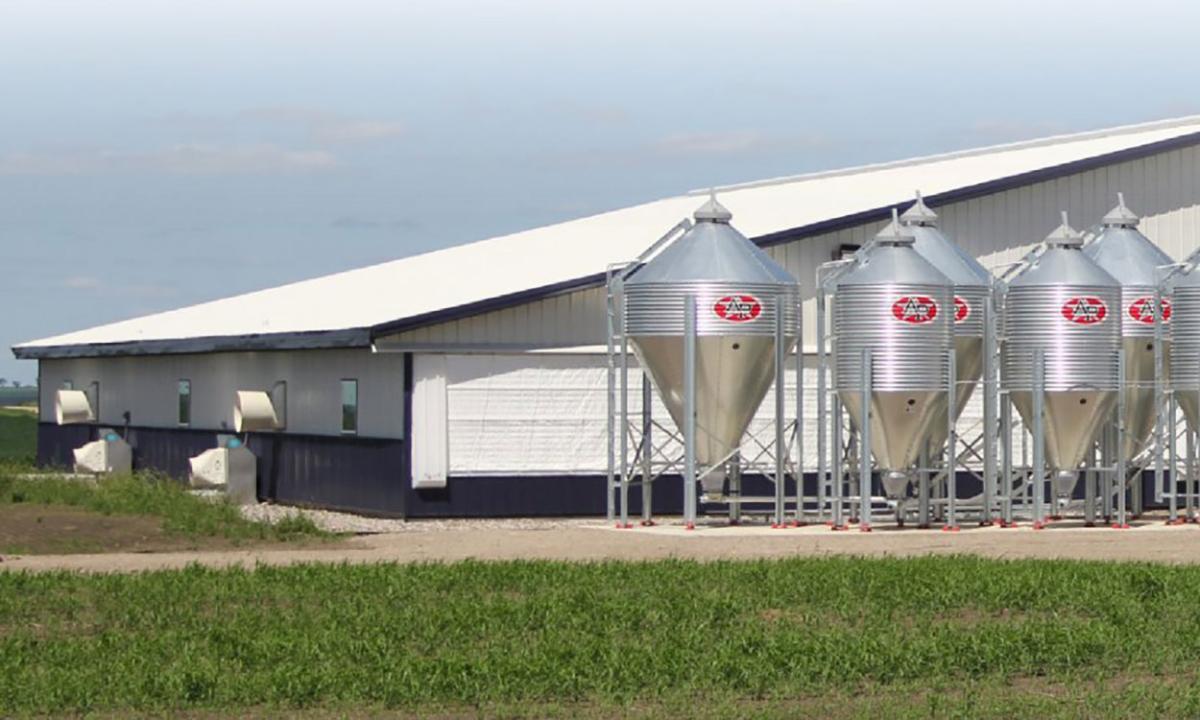

Phosphorus is a required nutrient for pigs added to diets in the form of monocalcium or dicalcium phosphate in addition to the phosphorus from the dietary ingredients. However, grains and oilseeds use phytate as the storage of phosphorus, which makes it largely unavailable to monogastric animals. Hence, phytase is widely used across the swine industry for the ability to break phytate bonds, thus releasing phosphorus for the animal to use and reducing the need for dietary supplementation, as well as phosphorus excretion via manure. Therefore, the objective of this study was to investigate the water usage of growing and finishing pigs fed diets without or with phytase included in the diet.
Research at South Dakota State University

Methods Used
In a study at the SDSU commercial wean-to-finish barn, grower and finisher pigs were housed at 26 pigs per pen. Each of the nine pens per treatment provided 8.8 square feet/pig, and feed and water were provided freely throughout the trial via one five space feeder of 5.8 feet total width and two cup waterers per pen, respectively. Treatment diets were corn-soybean meal diets with monocalcium phosphate or corn-soybean meal diets without monocalcium phosphate, but with 500 FTU/kg phytase. Pigs received diets over 2 phases in the grower period and 3 phases in the finishing period. The addition of limestone was adjusted to maintain the total Ca:P ratios across the diets. The available phosphorus in the diets without monocalcium phosphate was approximately half that of the available phosphorus in the diets with monocalcium phosphate. The monocalcium containing diets had greater sodium, ash, total phosphorus, total calcium, but similar neutral detergent fiber, crude fiber, crude protein, metabolizable energy, and lysine compared to the diets without monocalcium phosphate.
Pens of pigs were weighed every 14 days and feed disappearance was calculated according to a previously determined equation incorporating the density of the feed and the measurement from the top of the feeder to the top of the feed. Water usage was measured at each pen by recording the individual water meter reading.
Findings
There were no differences in average daily gain, average daily feed intake, or feed efficiency between pigs fed the different dietary treatments. However, water usage was nearly twice as much for pens of pigs fed diets without monocalcium phosphate, but with phytase, compared to pens of pigs fed diets with monocalcium phosphate and no phytase on each of the weigh days during the study period. This effect was previously described in birds, where it was suggested that the increased osmolality within the gut due to the release of nutrients and minerals by phytase increased the water demand to maintain homeostasis. Furthermore, the authors suggest that adjustments in diet formulation may be necessary to reduce water usage and to improve litter quality. Although the issue of water excretion may be less important for swine housed on slats, total water usage is an important consideration in the sustainable production of pork.
In Summary
The use of phytase in swine diets is nearly ubiquitous, because of the advantages such as diet formulation flexibility and reduced the need for phosphorus additions to the diet. However, further research may be warranted to determine how phytase inclusion influences water usage.
References
- Cowieson, A.J.; Acamovic, T; Bedford, M.R. The effects of phytase and phytic acid on the loss of endogenous amino acids and minerals from broiler chickens. Br. Poult. Sci. 2004, 45, 101.
- Lozinski, B.M.; Frederick, B.; Li, Y.; Saqui‐Salces, M.; Shurson, G.C.; Urriola, P.E.; Wilson, M.L.; Johnston, L.J. Effects of water quality on growth performance and health of nursery pigs. Transl. Anim. Sci. 2022, 6, txac002.
- Miller, H.W; McClellan, K.; Perez-Palencia, J.Y.; Samuel, R.S.; Levesque, C.L.; Thaler, R.C. Impact of water flow rate on finishing pig performance. Transl. Anim. Sci. 2022, 3, txac125.
- Samuel, R. Total dissolved solids (TDS) less than 1000 ppm in drinking water did not impact nursery pig performance. Vet. Sci. 2022, 9, 622.
- Zeamer, K.M.; Levesque, C.L.; Cortus, E.L.; Thaler, R.C. Findings from a survey of finishing‐barn management benchmarks with South Dakota pork producers. Appl. Anim. Sci. 2021, 37, 320–333.




